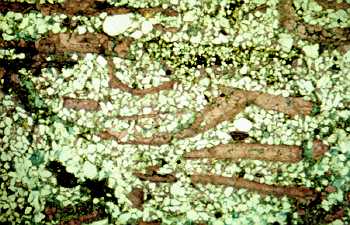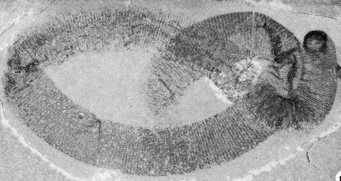 A fossil is a feature preserved in a rock that indicates the presence of ancient life. Body fossils are parts of organisms such as shells, bones and leaves. Footprints, trails and burrows in rocks also demonstrate the presence of ancient life, even though no part of the body is present, and are called trace fossils. Recognition of fossils is based on comparison of modern and ancient material and follows the principle of uniformitarianism. A fossil is a feature preserved in a rock that indicates the presence of ancient life. Body fossils are parts of organisms such as shells, bones and leaves. Footprints, trails and burrows in rocks also demonstrate the presence of ancient life, even though no part of the body is present, and are called trace fossils. Recognition of fossils is based on comparison of modern and ancient material and follows the principle of uniformitarianism.
 |
|
The photograph above shows bachiopod shell fragments in a thin (30 millionths of a meter) slice of rock, as observed with a microscope. The brachiopod shells are the pink areas. The pink color is due to a chemical stain that was applied to the rock to help identify the mineral calcite. When brachiopod shells form, they have an intricate internal structure. In the photograph, this structure is not seen. Rather, large calcite crystals occupy the area of the original shell The large crystals indicate that the brachiopod shell dissolved and new crystals formed in the area occupied by the original shell. This process is a type of diagenesis.
|
 Diagenesis refers to the chemical and physical changes that occur in sedimentary geologic materials after their initial deposition or formation. During the Silurian Period, reefs in Wisconsin and Illinois consisted of shells and soft mud composed of calcium carbonate. The shells and mud eventually crystallized into rock called limestone. Later in geologic time, salt-rich waters introduced magnesium into the deposits, changing the limestone into a rock called dolostone, which consists of calcium-magnesium carbonate. Diagenesis refers to the chemical and physical changes that occur in sedimentary geologic materials after their initial deposition or formation. During the Silurian Period, reefs in Wisconsin and Illinois consisted of shells and soft mud composed of calcium carbonate. The shells and mud eventually crystallized into rock called limestone. Later in geologic time, salt-rich waters introduced magnesium into the deposits, changing the limestone into a rock called dolostone, which consists of calcium-magnesium carbonate.
 Although some fossils have not been changed from their original composition, most fossils have undergone some degree of diagenesis. Petrification occurs when tiny spaces in bone or wood are filled by new minerals. Silicification is the alteration of a shell composed of calcium carbonate into a fossil shell composed of silica (SiO2). Although some fossils have not been changed from their original composition, most fossils have undergone some degree of diagenesis. Petrification occurs when tiny spaces in bone or wood are filled by new minerals. Silicification is the alteration of a shell composed of calcium carbonate into a fossil shell composed of silica (SiO2).

 Shells may also be dissolved during diagenesis, leaving only their impression in the rock. This is the way most Silurian reef fossils of Wisconsin and Illinois are preserved. The external mold is an impression that preserves the appearance of the outer surface of a shell. The internal mold is an impression of the inner surface of a shell. External and internal molds of the same shell are often very different in appearance. Shells may also be dissolved during diagenesis, leaving only their impression in the rock. This is the way most Silurian reef fossils of Wisconsin and Illinois are preserved. The external mold is an impression that preserves the appearance of the outer surface of a shell. The internal mold is an impression of the inner surface of a shell. External and internal molds of the same shell are often very different in appearance.

 Most body fossils represent hard and durable parts of an organism, such as shells, bone, or teeth. Soft tissues, such as tentacles, eyes and internal organs are consumed by microbial organisms and are not preserved as fossils. Only in rare cases are soft tissues or entirely soft-bodied animals preserved as fossils, as shown in the photograph of a worm to the left. these cases usually involve a lack of oxygen in the original environment, which inhibits the activity of microbial organisms. Most body fossils represent hard and durable parts of an organism, such as shells, bone, or teeth. Soft tissues, such as tentacles, eyes and internal organs are consumed by microbial organisms and are not preserved as fossils. Only in rare cases are soft tissues or entirely soft-bodied animals preserved as fossils, as shown in the photograph of a worm to the left. these cases usually involve a lack of oxygen in the original environment, which inhibits the activity of microbial organisms.
|


